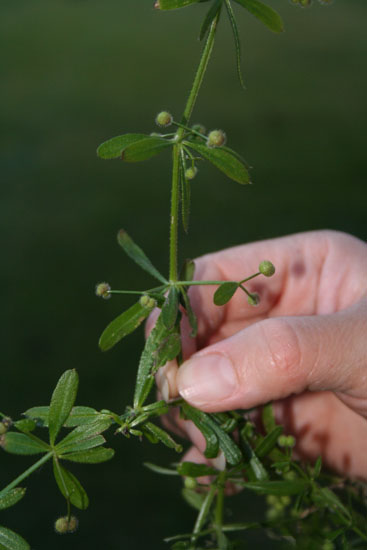Issue 6, May 29, 2012
Catchweed Bedstraw -- A Catchy Little Weed
I've had a few queries about catchweed bedstraw lately. Galium aparine is an annual weed that has been quite prevalent this spring. It has a semi-prostrate habit and is commonly found in shaded or wooded areas climbing up over the top of surrounding vegetation. It is primarily found in landscapes, nurseries, small grains, and meadows. It earned the name bedstraw when it was used to minimize matting in mattress filling. This weed may also be known by other names including cleavers, Velcro plant, stickywilly, goose-grass, grip-grass, snatch-grass, and catch-grass. The leaves are narrow, but it's not a grass at all. Stickywilly? That's just a good name.

Catchweed bedstraw.
The leaves are sessile in whorls of 6-8 at the nodes. The leaf blades are lanceolate in shape. Overall, the plant is fairly hairy or prickly allowing it to "catch" easily on skin, clothing, or fur so that seeds are disseminated. The stems have recurved prickles on the ridges and leaves; they are square shaped and break easily. The upperside of the leaves are hairy. The underside has short prickly hairs which allow you to perform magic tricks to impress young children. I'd advise against it though. Recently, I stuck one to my arm in order to demonstrate my profound ability to make it "hang magically" from my arm. Pulling it off hurt quite a bit and surprisingly the pain lasted for a couple of days. My 5 year old was only slightly impressed with my super powers. But what else is new?
The flowers of catchweed bedstraw are produced in May-June in clusters near the axils of the whorls. They are white with 4 petals and 4 stamens. Flowers can occur in only 8 weeks after germination. The seeds are small (2-3 mm in diameter) and typically covered in small hooks, again to aid in dissemination. Seeds are capable of germinating over an extended period of time. One plant will typically produce 100 to 400 seeds, but occasionally 3,000 or more can be produced according to IPM specialists at the University of California. Seeds can remain viable in the soil for up to three years.
Catchweed bedstraw can be found across North America. It appears to be a more serious problem in the Northwestern states. It can be pulled fairly easily especially in moist soil as it has short roots. Blooming plants should then be discarded so that seed development does not continue. The preemergent herbicide oryzalin can provide fair control of catchweed bedstraw. Postemergent herbicide options include glyphosate, oxyfluorfen, quinclorac, carfentrazone, and diclobenil. This list is not all inclusive but is provided as a starting point. Always be sure to read and follow all label directions. Prevention of seed dispersal is likely the best way to prevent future infestations of this plant.
A similar species is smooth bedstraw (G. mollugo) which is a perennial and is smooth overall except at the leaf margins. Carpetweed has a similar growth habit and leaf arrangement, but the stem is round and it is more branched.
Photos of catchweed bedstraw can be found here: www.inhs.illinois.edu/animals_plants/plants/ilgallery/ThePlants/GGenera/GalApa/GalApa.html. (Michelle Wiesbrook)
Author:
Michelle Wiesbrook